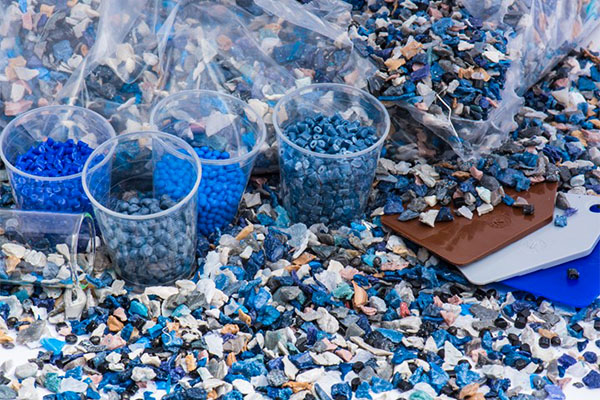Plastic Regrind: Cost-Saving & Plastic Sustainable Solutions
There is frequently leftover thermoplastic material after injection molding that is left unusable, such as scrap components, runners, and sprues. It is wasteful to throw away these scraps. This extra material can still be efficiently reused even after only one processing cycle, providing it follows certain rules. This extra material is gathered and ground into smaller granules, which are known as plastic regrind.
The majority of material producers agree that up to 30% suitable plastic regrind material can be combined with virgin material without impairing the primary material’s mechanical qualities. One of the numerous benefits of this method is that it not only protects the integrity of the material but also results in significant cost savings, totaling to roughly 15%.

What is Plastic Regrind and Its Benefits?
Plastic regrind, in the context of plastic manufacturing, is a recycled material derived from the remnants of thermoplastic materials left over after processes like injection molding. It serves as an environmentally responsible and cost-effective way to enhance resource utilization while minimizing the demand on natural resources. However, the utilization of plastic regrind comes with a caveat: it is not ideally suited for applications that demand an extremely high level of precision and consistency.
The inclusion of plastic regrind material in the manufacturing process, like other aspects of injection molding, is a precise science that demands accuracy. The extent to which plastic regrind can be incorporated into a project, and its potential impact on the primary material’s properties, varies significantly based on several variables. These variables include the type of resin being used, the original processing methods employed for the plastic regrind, the size of the plastic regrind granules, and the potential presence of contaminants such as dirt, dust, or moisture in the plastic regrind material.
A crucial consideration is the assessment of how the plastic regrind’s heat history and processing may have altered its physical, chemical, and flow characteristics, and how these modified properties might influence the same attributes of the primary melt when regrind is introduced. It’s essential to recognize that plastic regrind will not behave in precisely the same manner as virgin resin. The extent to which plastic regrind can be safely employed is contingent on the performance requirements of the final product and the tolerances that must be maintained to meet those specifications.
The incorporation of plastic regrind is a practice that demands careful consideration and precise management to ensure optimal results.

Crucial Factors to Consider Plastic Regrind
There are some key considerations of plastic regrind in practical operation, such as degradation, granule dimensions, outside contamination, controlled usage.
Degradation
It is well-understood that most polymers may experience some level of degradation during the injection molding process. However, for the most part, the presence of degraded material in the regrind does not significantly compromise the quality of the virgin resin, provided that the regrind constitutes 30% or less of the melt.
The primary cause of degradation is heat, and it’s imperative to avoid overheating the material during processing or subjecting it to excessive shear forces. Neglecting the heat history of plastic regrind can potentially lead to product failures in real-world applications. The injection molding process can also result in the formation of shorter polymer chains within the regrind, which can substantially impact the quality and performance of the final product.
Granule Dimensions
In the regrind process, residual plastic material, including tiny granules resembling dust and any rejected parts, is gathered and processed through a grinder. This reduces the granules’ sizes, ranging from dust-like to up to half an inch.
While these granules may not melt at the same rate, resulting in some variations in the molded part, these variances are typically not significant enough to compromise quality or performance. However, for products where aesthetics hold high importance, the use of regrind can potentially lead to minor surface blemishes or discolorations.
Outside Contamination
Maintaining cleanliness in material handling and operations is imperative for any plastic injection molding project, including those involving regrind. All plastics, whether virgin or regrind, must be free of contaminants such as dust, dirt, skin oils, or foreign particulates like metal or remnants of other plastic products. Moisture poses a significant concern as well; improperly dried regrind can undergo significant changes in its physical properties during the injection molding process, jeopardizing the quality and performance of the final product.
Controlled Usage
A controlled and consistent utilization of regrind materials is a key strategy for reducing overall costs. When a consistent percentage of regrind is used in a product line, the manufacturing process can be adjusted to consistently accommodate this blend ratio. However, any alterations in the regrind percentage require corresponding adjustments in the injection molding process.
Plastic Regrind at Sungplastic
Incorporating plastic regrind into manufacturing processes is a sustainable practice that aligns with an environmentally responsible approach, as exemplified by Sungplastic’s commitment to reducing plastic waste. By understanding the nuances and considerations of regrind utilization, we can not only lower costs but also promote responsible resource management.
In our plastic manufacturing solutions, we implement precision manufacturing and design for manufacturing analysis, strict parts design and mold design for sustainability, and quality control, to reduce plastic waste and plastic recycling and have gained a significant effect.
For a comprehensive exploration of the versatility and value of plastics, please explore other informative articles on our website.
Get a free quote and design analysis today.
We’ll reply to you within 6 working hours.
We respect your privacy.
+86 139 2927 4777 (WhatsApp, Wechat)
